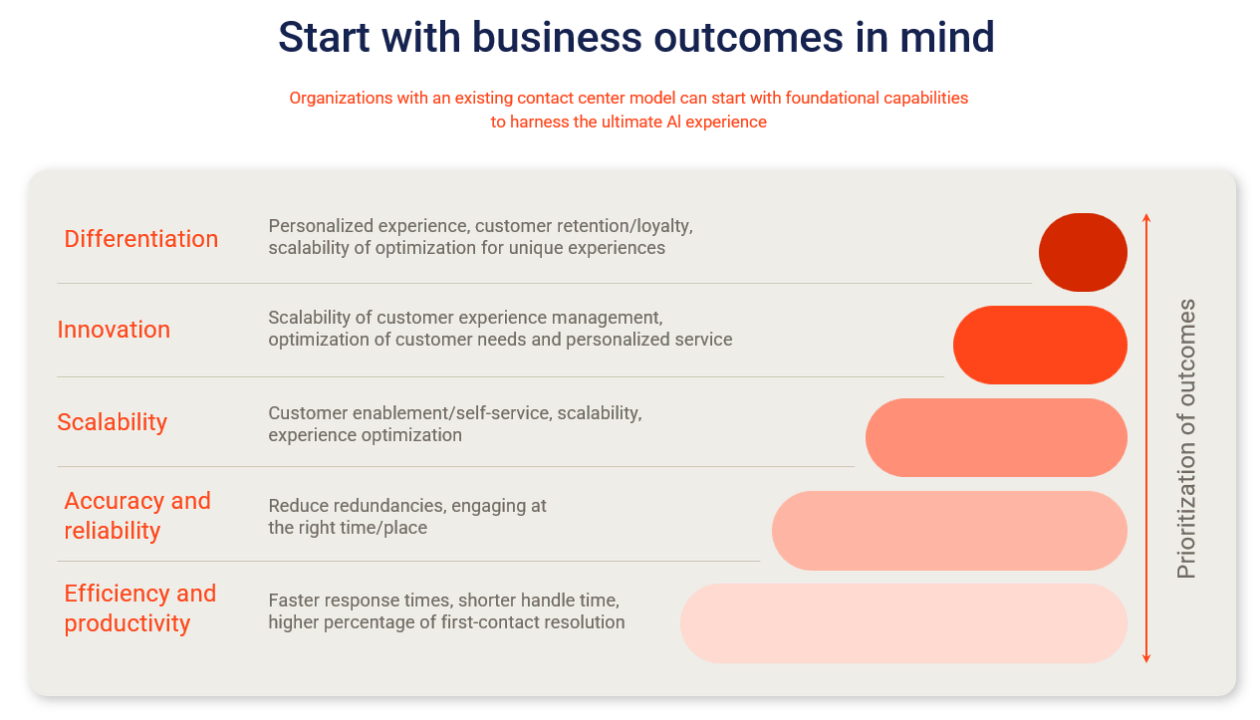Your Genesys Blog Subscription has been confirmed!
Please add genesys@email.genesys.com to your safe sender list to ensure you receive the weekly blog notifications.
Subscribe to our free newsletter and get blog updates in your inbox
Don't Show This Again.

The promise of artificial intelligence (AI) in customer experience is huge. According to a recent Forbes Advisor report, most business owners think AI will benefit their businesses. A substantial number of respondents to the survey (64%) anticipate the technology will improve customer relationships and increase productivity. And 60% expect AI to drive sales growth.
But without a clear and well-thought-out strategy on how to implement it, your results could be subpar. Tapping into the true transformational value that AI promises requires effort and a thorough strategy to maximize your return on investment (ROI) and minimize risks.
Since the explosive buzz around generative AI in 2022, many organizations have embraced the technology to boost efficiency and productivity — and provide better self-service options. But, while this has provided some organizations with quick ROI, many have yet to see the powerful transformation the technology can offer.
That’s not to say the early impact of AI hasn’t been profound. Businesses have leveraged AI and automation to save time and money through several solutions.
AI-powered virtual assistants enhance customer engagement and reduce response times for many interactions. When human agents are needed, artificial intelligence tools empower them with post-interaction auto-summarization and real-time support.
Meanwhile, behind the scenes, AI provides organizations with accurate workload forecasting to optimize schedules, reduce overtime and improve employee satisfaction.
These quick wins have illustrated the power of AI, but they are just a start. The real transformative potential still eludes many.
With the hype around AI at a fever pitch, new vendors and new solutions seem to crop up daily. And many organizations that are adopting AI tools are expecting great things.
But adopting this technology requires careful consideration. Let’s look at a few areas you need to understand before a widespread rollout.
Explainability: Explainability in AI is the ability to describe an AI model’s outcomes in understandable terms. A lack of understanding of how artificial intelligence tools work and trust around the output can result in ethical and legal concerns and safety concerns in certain industries. Knowing how the AI made a decision is essential to building that trust and understanding.
Transparency: Similarly, transparency in the system’s inner workings is crucial to success, leading to faster and better decision-making. It’s so essential to accountability that regulators around the world are pushing hard for greater transparency.
According to “Generational dynamics and the experience economy,” 84% of consumers say they have the right to know if they’re interacting with a bot.
Embedded bias: Because biases can be inadvertently embedded into systems, it’s crucial to see how AI makes its decisions. Human biases around race, gender, ability and more influence the data on which tool is trained and can result in inaccuracy, inequality and customer mistrust.
Lack of a purpose-built solution: “Bolt-on” point solutions are fine for certain tasks, but don’t provide the value expected because they lack the two things essential for AI success: access to good data and context on how it directly relates to your customers — and your business.
Bad data: Data is the bedrock of AI. So bad data will result in bad AI. A system that’s trained on flawed (or biased) data provides flawed (and distorted) results. High-quality data is a necessity.
Poor security: As with all corporate and customer data, cybersecurity, governance and ethical considerations regarding how data is procured, how it’s used and where it’s stored are critical.
Privacy violations: AI systems require a great deal of data and personal information on which to train, raising new concerns around personally identifiable information (PII) and privacy. Using personal data without consent can result in costly fines or damaged reputations.
There are often three levels for beginning your adoption project.
AI point solutions plateau in their rates of return because they’re designed to address one thing. They might deliver good short-term value, but they won’t help to transform the organization. Point solutions aren’t designed to work together; they aren’t integrated; and you need to continually update them for your technology ecosystem.
Whether you’re an AI beginner or looking for the next stage of AI success, it’s important to rethink how you approach the technology and move toward a more comprehensive strategy. This strategic approach to AI adoption will set you up to reach new peaks of value.
Taking a strategic approach to your AI adoption can help you reduce risk and speed time to value. Here are some factors to consider.
Plan around use cases: What do you want to achieve with AI? Is your first goal to improve speed resolution times? Or do you need to improve personalization to deliver a great customer experience? Maybe you want to optimize workloads for your contact center agents. Start with one use case and then expand once you’re seeing results.
Balance quick wins with long-term strategy: Taking too long to achieve value is a downfall of many AI projects. Still, it’s crucial that while your project must achieve value fast, it must also be aligned with your long-term goals for AI and the business.
Focus on delivering returns: To build momentum and buy in, tangible ROI is essential. To grow your use of AI and achieve greater outcomes, you’ll need to prove success to key stakeholders.
Minimize risk: Take the necessary steps and select a solution that provides transparency, explainability and good data control. You should also find a solution that meets any AI ethics guidelines you created as an organization — and adheres to necessary governance and compliance regulations.
Mature to an AI-powered platform: To tap into the transformative power of AI, implement an AI solution can drive contextual data across activities not just improve a task here or there. Context is essential for an AI-powered platform; it ensures the AI delivers relevant and understandable responses that align with the specific actions and customer interactions. By continuously learning from each step of customer and employee journeys, the AI becomes more accurate and adaptive. Context allows the AI to provide explainable, real-time responses. This makes suggestions more actionable and trustworthy. And this iterative input creates a system in which the AI not only reacts appropriately but also improves over time. And that enhances both the user experience and outcomes.

As the application of AI matures in the organization, business outcomes will improve.
Each business outcome builds on the foundation you’ve created until you’ve achieved a deeply personalized customer experience that fosters loyalty.
Most organizations today are at the efficiency and productivity stage of AI use — doing the same things they’ve always done — only faster and better.
Building on that, organizations can use AI to better understand and act on customer intent. This provides them with the right customer information at the right time to drive personalization and growth — and to ultimately improve customer interactions.
From there, scalability and optimization are possible, improving customer journeys, self-service and automation for more scalable CX.
At this point, organizations can truly embrace innovation, differentiating services by offering unique experiences.
Finally, although never the end of development, you achieve hyper-personalization and move beyond the single journey to a more holistic focus on customer relationships.
This is what truly transformative AI looks like. It’s not doing the same thing and expecting different results. It’s using the power of technology to innovate, personalize experiences and think outside the box.
You don’t have to go on this tech journey alone. Genesys has deep expertise to help you understand your needs and map out a framework to meet them. Our approach balances short-term value and long-term strategy with a focus on meeting security, ethics and privacy needs.
We can provide you with a clear, step-by-step roadmap to achieving the quick wins you need to prove ROI while preparing you for the future.
Learn more about our approach in “The Genesys Cloud AI progressive adoption model” ebook.